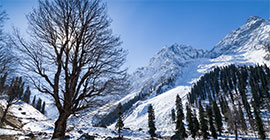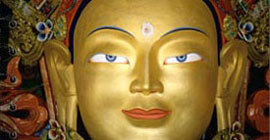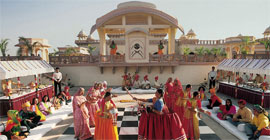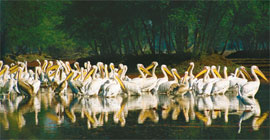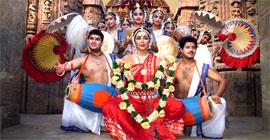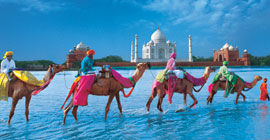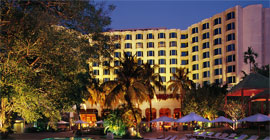BIKANER
Home | Bikaner
Junagarh Fort
Junagarh Fort is an unassailable fortress, which has never been conquered. Built in 1593 A.D. by Raja Rai Singh, one of the most distinguished generals in the army of Emperor Akbar, the fort is a formidable structure encircled by a moat. The main entrance to the fort is Karan Pol [gate], that is east facing. Next to it is the Suraj Pol meaning the sun gate. The fort situates in it some very magnificent palaces like Anup Mahal, Ganga Niwas and Rang Mahal or palace of pleasure. The Har Mandir is the majestic chapel for the royal family for worshipping their gods and goddesses. These palaces, constructed in red sandstone and marble, make a picturesque ensemble of courtyards, balconies, kiosks and windows dotted all over the structure. The premises also houses a museum which is an array of a rich collection .
Lalgarh Palace
The Lalgarh Palace displays an exclusive blend of Oriental and European architectural styles. Constructed of exquisite red stones it is a royal building with overhanging balconies and delicate latticework. The intricate filigree work exhibits the refinements and delicacy of craftsmanship. The terraced lawns and the Bougainvillea bushes add to the splendor of this palace.
Gajner Palace
Gajner Palace, Bikaner which is constructed of red sandstone is very famous amongst the roll of Heritage Hotels in Bikaner. It stretches over a sprawling terrain of 6000 acres. It is remarkable for its architectural grandeur in addition to its plush suites and rooms. The greenery in the vicinity of Gajner Palace, Bikaner along with its splendid lawns, the charming twittering of birds, the leisurely walk of peacocks – all play their roles in making it a cherished destination for tourists.
Karni Mata Temple
The Karni Mata temple, Deshnok is situated 30 km from Bikaner. The temple is dedicated to an early 15th century mystic, considered to be a reincarnation of Goddess Durga. This temple is quite famous for a large number of brown rats running around the temple complex fearlessly. It is believed that the souls of dead Charans (traditional bards, the devotees of Mata) reside in these rats. It is considered very lucky to spot a rat in the temple. During the time of aarti, these rats are offered sweets, grains, etc by the devotees. Ganga Singh, the former ruler of Bikaner, got the temple constructed totally of marble. Karni Mata temple, Rajasthan has silver and gold domes. Even the mandap and the panels above the image are made up of gold. The main gate of the Deshnok Rat temple, Bikaner has been intricately worked upon. The Karni Mata temple is thronged not only by the Rajasthanis. Rather, devotees from all over India and even abroad pay a visit to the temple. At the time of Navaratri, a fair is held at the temple. Devotees from places far and wide flock to the temple at that time, some even on foot. Day by day, the faith in Karni Mata is increasing, attracting more and more devotees to the place. Whenever the wishes of the devotees get fulfilled, they offer silver and gold to the goddess at the temple.
Bhandasar and Sandeshwar Temples
There are two main Jain Temples "Bhandasar" and "Sandeshwar", located in the south east end of Bikaner. The Bhandasar Jain Temple is dedicated to the fifth Tirthankar "Sumtinath" and the construction of the temple was started in1468 A.D. by a wealthy Jain merchant, Bhandasa Oswal. According to myth, it is said, that 40, 000 kg of ghee had been used in laying the foundation of this temple. It is carved in red sand stone and white marble, famous for its carvings, paintings, structural beauty and artistically designed statues. Whereas, the Sandeshwar Jain Temple is adores with the marble image of Sandeshwar and other Jain Tirthankars. This attractive Sandeshwar Temple is far famed for its superb carving around the doors, columns and painted pillars.
Shiv Bari Temple
Fortified by a high wall the temple is dedicated to Lord Shiva. Maharaja Doongar Singh constructed it in the ninth century in the memory of his father Maharaj Lall Singhji. The temple has a beautiful wall panting of Nandi Bull facing the Shiva Lingam. This is located on the way to the camel town.
Bhaironji Temple
Bhaironji Temple located at Kodamdesar near Bikaner in Rajasthan, India is definitely one of the most important places to see in this part of Rajasthan, India.
Ganga Singh Museum
Ganga Singh museum is popularly described as the best museum in the state, it displays a rich array of archaeological discoveries from prehistoric Harrapan and early Gupta period. Ganga Singh Museum is considered to be the best in Rajasthan for its treasure trove of artefacts from Harappan and Gupta periods. Paintings, terracotta, carpets, pottery, art and crafts, and Rajput weapons are on display.
Sun Gate
Sun Gate is the main entrance to the fort. Among the notable of these palaces are the exquisitely beautiful Chandra Mahal or the Moon Palace with marvelous paintings, mirrors and carved marble panels, and the Phool Mahal or Flower Palace ornate with glass and mirror work. Other palaces worth visiting are the Anup Mahal, Karan Mahal, Dungar Niwas, Ganga Niwas, Gaj Mandir and Rang Mahal, Gigantic columns, arches and graceful screens adorn the palaces from within.
Kalibangan
Nestled at 205-km away from Bikaner, Kalibanga, is located in Hanumangarh district of Rajasthan. Situated on the left bank of the Ghaggar (Ancient Saraswati) river, usually dry but occasionally flooded, at a distance of about 5 km from Pilibanga Railway Station, Kalibangan has equal Historical importance like Harappa and Mohenjo-daro. Saraswati was a part of the Indus River system. Historic ruins at Kalibangan can be seen as excursions from Bikaner that keeps high importance for the people who have interest in history. Kalibangan has cosmic historical importance as it was an important part of the ancient Indus Valley Civilization that flourished during 3000 B.C. to 5000 B.C.
Shri Sadul Museum
Shri Sadul Museum is located at Lalgarh Palace, the red sandstone palace located in Bikaner. It is housed in the Ganga Niwas, which covers the entire first floor of the palace. The museum displays a unique collection of miniature paintings, manuscripts, weaponry and old photos depicting royal hunts. It also houses the personal possessions of former Bikaner rulers, which includes golf tees, camera, clothes, books and earplugs. The museum is open daily from 10:00 to 17:00 hrs, except on Wednesdays. It can be visited on a small entrance fee. Photography is not allowed. Shri Sadul Museum is about 3 km from Bikaner Junction Railway Station and 2 km north of downtown area.
Rajasthan State Archives
The Rajasthan State Archives in Bikaner is one of the most worth visiting spots and is counted among the top Museums and Galleries in Rajasthan. It holds some very invaluable administrative records of Mughal Period such as Persian Farmans, Nishans, Manshurs, Akbarat, Vakil Report, Arzdasht and Khatoot. It also contains interesting records that were created during the administration of the Princely states of Rajasthan such as Bahiat, Pattas, Parwanas, Rukkas, Chithiat and so on.The Bikaner Rajasthan State Archives is obviously one of the very famous tourist spots for housing unmatched and truly priceless collection of records. The record it holds is very significant to researchers all over the world. Besides, this custodian of ancient records also offers amazing facilities like microfilming, reference library and research rooms which help researchers immensely. This apart, it also exhibits few very important documents to serve the tourist interest.
Katariasar Village
Situated approximately 45 km from Bikaner, on the Jaipur road, is the Katariasar village. The village provides a window into the ethnic rural and cultural life of Rajasthan. The village has a rich wildlife around it, consisting of Chinkara, Desert fox, Rabbit, Peacock, Parrot, Pat, etc. this village is also famous for its fire dancers, performing to the beat of drums on a bed of burning coals.
Devi Kund
Devi-kund, the Royal crematorium, is a world class example of architectural marvels of Historical India. Devi-kund is the site of royal cenotaphs (called Chattri in the local language) of the Bikaji Rathores, the great rulers of the Bika dynasty. Reflecting the Rajputana architectural style, the Devi-kund chattris steal the hearts of tourists.There are several chattris,Each Chhatri is dedicated to the memory of rulers of Bikaji dynasty and is situated on the exact place where they were cremated. The Chhatri of Maharaj Surat Singh is a fine example of architecture. The ceilings of the Chhatris displays some delicate Rajput paintings.
The Camel Breeding Farm
Bikaner-Camel Breeding Farm is one of the most preferred tours from Bikaner. The Camel Breeding Farm of Bikaner was founded by the Indian Council of Agricultural Research on July 1984. The Camel Breeding Farm is one of the largest camel farms of Asia and is located at Jorbeer, Bikaner. The Camel Breeding Farm of Bikaner, popularly known as Government Camel Breeding Farm, breeds the finest of camels in Bikaner. The Bikaner Camel Breeding Farm also conducts researches and experiments on the camels. The results obtained from the experiments are used to promote camel breeding. The Camel Breeding Farm in Bikaner employs the 'Raikas' or 'Rebars', local camel breeders, and aims towards making camel economically advantageous for the camel rearer of Bikaner.
Gajner Wildlife Sanctuary
This reserve and the forested hills are 32 km from Bikaner on the Jaisalmer road, are inhabuted by wildfowl, hares , wild boar, desert foxes and a number of deer and antelopes including blackbucks and bluebulls. The lake at Gajner attracts water birds in thousands. Imperial sand gouse migrate here in winter. Gajner Wildlife Sanctuary, houses the former Hunting lodge of Bikaner and has a beautiful lake surrounded by a dense forest. There is no other infrasturcture or accomodation for infrasturucture for Visitors except Gajner Palace Hotel and, there are no authorised guides at the sancuary. The reserve is only accesible through Gajner Palace Hotel vehicles( which can be hired by the non-guests aslo). Jeeps can take maximum six people.
Kolyatji
Kolyatji is located 50 kilometres from Bikaner. It is a temple complex of Kolyat and a holy place of pilgrimage for Hindus. The legend has it that Kapil Muni the advocate of Shankya yoga of the Hindu philosophy while journeying towards northwest was struck by the tranquility and peace of this place and chose to perform tapasya (penance) here for the redemption of the world. This place has since acquired great sanctity. The complex has several temples, pavilions and bathing ghats. A dip in the holy waters of the lake especially on Kartik Poornima (November) is considered very auspicious.







